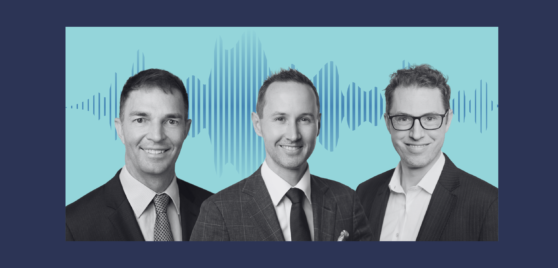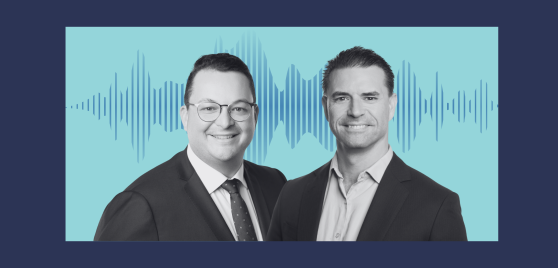Featuring Daniel Moore
LISTEN
READ
In our new podcast, Daniel Moore talks to Jason Guthrie about how IML’s large-cap funds performed during Q1 2024 including key stock movements and future outlook.
Lightly edited transcript below
Jason Guthrie: Hello and welcome to Navigating the Noise, a podcast by Natixis Investment Managers Australia, where we bring you insights from our global collective of experts to help you make better investment decisions. I’m Jason Guthrie, Head of Wholesale Distribution, and today I’m joined by Daniel Moore from IML.
Now Dan is one of IML’s young gun PMs. He’s been with the firm since 2010 and manages a number of the large-cap strategies across the firm. We spent a lot of time together on the road over the years seeing clients. And he’s certainly one of the more respected and experienced investment managers at IML, and I know you’re going to really enjoy hearing from him today. Rough agenda will include a market update for the quarter, how the funds have performed, some of the more recent opportunities in the funds and the outlook from here. Please enjoy the conversation. Dan, welcome to the podcast.
Daniel Moore: Thanks, Jase. It’s great to be here.
Jason: Dan, hard to believe we’re already through Easter. The first quarter’s done and dusted, reporting season’s done and dusted. And while we didn’t quite see the rally that we saw in the last quarter of ’23, it was a pretty solid quarter overall. What really drove markets and how did our portfolios fare at IML
Daniel: Yeah. Jase, I thought it was a pretty strong quarter, to be honest. Markets are up 5.4(%): that’s a great outcome, particularly on top of the recent gains as well. We’re up almost 20% since November. What drove that was really big moves in technology and consumer discretionary space, as well as the banks. And probably on the negative side, the iron ore miners got a bit of a hammering. They were down around 10%, BHP and Rio, with the iron ore price falling from 140 bucks to just under 100.
The IML funds did pretty well. I’m pretty happy…we delivered 4.8% [for the Investors Mutual Australian Share fund (IMAS)]. And really, that was driven by our industrial exposure and limited exposure to the resource names. We obviously have very little exposure to the technology space, so we didn’t get the upside from that sector, but we have a low exposure to the iron ore names, so that helped on the other side.
Jason: Okay. And how about some of the more specific holdings within the [IMAS] fund? Some of your high conviction bets. I would say…there was some pretty standout results for a number of your companies in reporting season. But how have their share prices really reacted through that, I guess, February, March, post-reporting season?
Daniel: It’s really interesting, when we look at the portfolio and our key holdings, I mean there’s always a couple of exceptions, but by and large, the results of the businesses were outstanding. I could list a few for you now. Suncorp – profit was up 52%, Aurizon was up 40%, Brambles was up 18, Medibank 16, CSL 13, Telstra 12. And they’re all big large holdings for the funds. Some really great results.
The share prices on the other hand didn’t always behave in line with the earnings, so Suncorp and Brambles were very strong. They were up 20% for the quarter, whereas CSL, Telstra, Steadfast, despite what we thought were really good results, were pretty flat. And that’s really because I guess investors are chasing, I guess the more exciting AI technology sectors, or the themes around interest rate cuts and the benefit that may have to the consumer.
And they’ve probably been selling, I’m guessing, the more defensive recurring earnings businesses, they’re the funding source for those purchases. Despite really good business performance, their share prices have been pretty flat. But in general, I’d say we’re really happy with how their underlying businesses are performing in the portfolio.
Jason: Yeah, it’s certainly been this rotation and I guess this risk on mentality over the last couple of months. Was there anything during the period that maybe didn’t perform as the team expected that you sold or potentially things that have been sold off that you’ve been taking the opportunity to buy into
Daniel: Yeah, I mean there’s always companies that don’t perform as well as you’d like. And then opportunities as well. Our key job, like the hardest job, is when a share price falls because of some sort of negative news is to really determine whether the information or the company performance is transitory, it’s a short-term issue, or (if) it’s a more structural issue where the investment thesis no longer holds and we’ve got to exit the position.
By and large, now we’re really pretty comfortable even with a couple of stocks that the earnings underperformed. The biggest one was Sonic Healthcare, which is the global leader in pathology. Their earnings were down 47% as obviously their cycling COVID testing revenues, which have almost fallen 99%. Their COVID revenues today are almost zero.
That earnings fall was a little bit sharper than we expected. We expected probably down around 40, so it was a little bit worse than we expected, but the share price has really taken a hammering. It’s down 40% from its highs now. When we look at the underlying business, when we back out COVID testing revenues, if we look at the base business, base business is growing revenues very strongly. Anywhere between 4 and 8% depending on the geography they operate. And the earnings base of the company is now, we’re forecast to be 40% higher than it was pre-COVID in 2019.
But if you look at the share price, the share price is lower than it was in 2019. We think that’s a fantastic opportunity and we’ve increased our holding in Sonic materially post the result. And what we love is buying great global leaders when they’re a bit out of favor. And we really think Sonic really ticks that box. Reminds us of other opportunities we’ve taken advantage of like Medibank during the cyber incident, or ResMed more recently around the market hysteria around Ozempic. No, we think it’s a great opportunity. We think the issues are short term. The business is performing really well, it’s winning market share. We really like the management team.
Jason: I know it’s one that you guys have been looking at for a while and you’ve held a smaller position, so sounds like a great entry point. Maybe just in wrapping up and taking a different tack look, certainly just outlook from here, certainly in the market speaking with clients and everyone continues to talk about inflation. Where that’s heading while central banks, I guess are offshore and they haven’t really met their absolute inflation targets at this point in the cycle, it does seem that the trend there with inflation is lower.
Certainly emerging markets and central banks offshore have been cutting rates for some time. And we’ve just seen the Swiss National Bank also joining in there it appears. It appears, look, rate cuts are certainly on the horizon in most people’s views. Is this expected locally here in Aus? And does that impact your positioning and how you’re thinking about things?
Daniel: Yeah, it’s a really tricky one. I think the best way from our perspective to think about macro forecasts and whether they’re interest rates or inflation is just to think about the risk return and what’s being priced into markets.
If we look at markets at the start of the year, markets were pricing in seven rate cuts and the markets have rallied since November 20-25% and in anticipation of rate cuts and lower inflation. There’s a lot of expectation priced in for rate cuts and lower inflation. And we definitely see risk that inflation is a bit more embedded in the system and the rate cuts won’t be as much as people were expecting. Certainly at the beginning of the year. Interestingly, markets are now pricing in only two and a half rate cuts, but we’re still pretty much at all time highs.
Jason: Yeah, we also had overnight a bit of volatility with some comments from some of the Fed members. Looks like things are changing by the day.
Daniel: Yeah, April month is definitely looking quite a bit different to what we’ve seen since November. Yeah, I think, when we talk to companies we are hearing cost inflation is definitely not going away. It looks like minimum wage is going to go up between 4 to 5% for the next financial year. Rents are growing strongly for everyone, unfortunately. Utility bills, insurance premiums. Yeah, I think we definitely see risks compared to what the market’s pricing in. And we’re very cautious (of) stocks, which are factoring in strong rate rises. So if you look at the retailers, the JB Hi-Fis, the Nick Scalis, the Wesfarmers, in March they rallied 25-30%.
Jason: Incredible.
Daniel: We think those sorts of stocks are quite vulnerable if inflation is more persistent.
Jason: All right. Well, thank you, Dan. We might wrap it up there. As always, it’s an absolute pleasure. We really appreciate your insights and thank you of course to our loyal listeners for joining us today. Please don’t forget to provide your feedback and tune in again very soon to hear more from our global collective of experts.
INVESTMENT INSIGHTS & PERFORMANCE UPDATES
Subscribe to receive IML’s regular performance updates, invitations to webinars as well as regular insights from IML’s investment team, featured in the Natixis Investment Managers Expert Collective newsletter.
IML marketing in Australia is distributed by Natixis Investment Managers, a related entity. Your subscriber details are being collected by Natixis Investment Managers Australia, on behalf of IML. Please refer to our Privacy Policy. Natixis Investment Managers Australia Pty Limited (ABN 60 088 786 289) (AFSL No. 246830) is authorised to provide financial services to wholesale clients and to provide only general financial product advice to retail clients.










